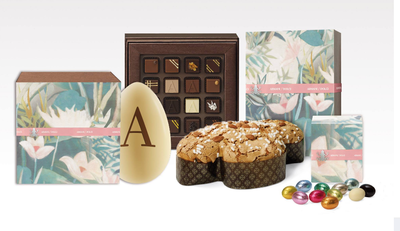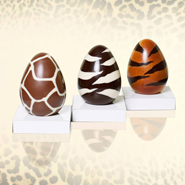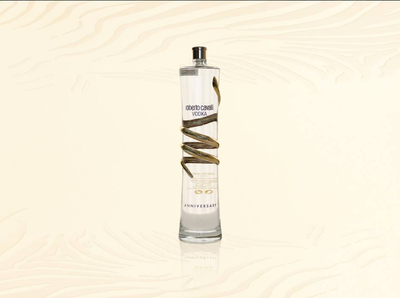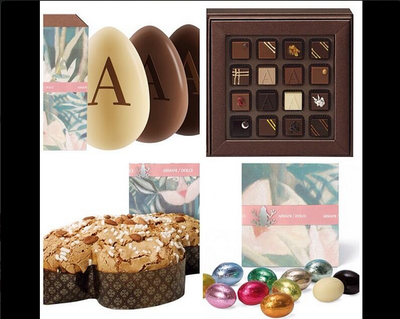Franchising, retail, business

15/04/2014
As Easter approaches, Italian fashion labels Giorgio Armani and Roberto Cavalli aim to be a part of consumers’ Easter celebrations with their food and beverage lines.
The brands promoted their culinary offerings via social media, letting brand loyalists know of another way to take the labels into their homes.
Since Easter is a food-heavy holiday, it gives these fashion houses the opportunity to remind consumers that they make products in categories other than apparel and accessories.
“It’s just another way of generating publicity for the brands,” said Al Ries, founder and chairman of Ries & Ries, a Roswell, GA-based marketing strategy consultancy.
 ”Easter is a particularly good time to promote various food products and brands.
”Easter is a particularly good time to promote various food products and brands.
“So the fashion brands are just jumping on the opportunity to get media mention,” he said. “It’s not a strategy to establish a new line of food products.”
Mr. Ries is not affiliated with Armani or Roberto Cavalli but agreed to comment as an industry expert.
Armani and Roberto Cavalli did not respond by press deadline.
Sweet tooth
Armani is publicizing its Armani Dolci special collection of chocolates and baked goods for Easter. The products all come in floral boxes with a frog icon.
Consumers can buy egg-shaped chocolates with A’s printed on them or a box of square shaped chocolates with A’s etched in them.
A featured item is the Colomba Cake gift box. The cake, a traditional Italian Easter item, is made in the shape of a dove, a reference to a 6th century legend that while King Albion had Pavia under siege, he received a dove-shaped cake as a peace sign.
Roberto Cavalli has a line of candy and spirits available online and in-store at Café Giacosa, a Florence eatery that the brand restored.
The label took the animal prints it is known for and embellished chocolate eggs with them. Continuing the theme, a leopard-covered box of chocolates includes candies with giraffe and zebra markings.
To celebrate its 40th anniversary, the house created a special hand-decorated edition of its vodka, which includes a clear bottle with a golden snake circling it. The snake has appeared on all of the bottles since the label’s vodka launched.

Consumers can buy individual bottles of vodka in 3 or 6 liter sizes, or purchase a gift set that includes a bottle and matching shot glasses.
Bottles of wine and gift sets in animal prints are also available.For both of these brands, making special food items with brand references on the packaging or the food itself, allows them to be a part of consumers’ celebrations. This is perfect for brand loyalists, who want the brand to be present in all aspects of their lives.
Food as experience
Food is a central part of most holidays, but for some it is front and center, serving as a gift item.
London department store Fortnum & Mason targeted culinary-inclined consumers with a Valentine’s Day promotion that concentrated on a romantic meal rather than the traditional gifting of jewelry and flowers.
The retailer used its reputation as a well-known food purveyor on its Facebook account to influence online and in-store purchases of consumers planning a Valentine’s Day dinner. Fortnum & Mason likely saw an increased focus on its edible offerings in the days leading up to Valentine’s Day as other retailers promoted material goods (see story).
Other marketers have seen the opportunity to mesh fashion and food for Easter promotions.
Saks Fifth Avenue’s New York in-store restaurant Café SFA has created a Fabergé-themed egg dish to tie into the department store chain’s Easter display by the jewelry brand. Saks is the official retail partner of Fabergé’s The Big Egg Hunt, and its flagship store in New York is a featured destination for the scavenger hunt, with nine artist-designed eggs in-store. By creating a signature dish for this event, Café SFA is able to provide consumers with a well-rounded experience at Saks that blends fashion, art and cuisine (see story).
Saks is the official retail partner of Fabergé’s The Big Egg Hunt, and its flagship store in New York is a featured destination for the scavenger hunt, with nine artist-designed eggs in-store. By creating a signature dish for this event, Café SFA is able to provide consumers with a well-rounded experience at Saks that blends fashion, art and cuisine (see story).
This may keep these brands top of mind, but it will not necessarily lead to sales.
“A fashion brand on a food product will capture the attention of consumers,” Mr. Ries said. “Whether this will result in very many sales remains to be seen. My feeling is that they won’t sell very well, but a lot depends on the how they the fashion brands are positioned in food outlets.
“It will certainly be helpful in keeping the fashion brands in the public’s eyes,” he said. “And it will be helpful in generating publicity. But I doubt whether the cost of producing and distributing the fashion food brands will be worthwhile from the companies’ points of view.”
Fonte: luxurydaily.com